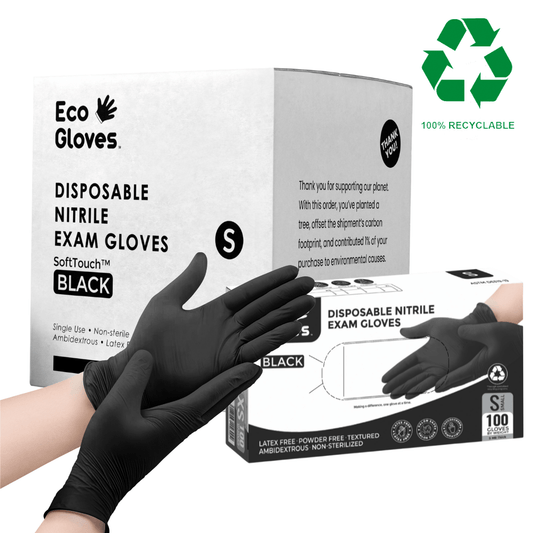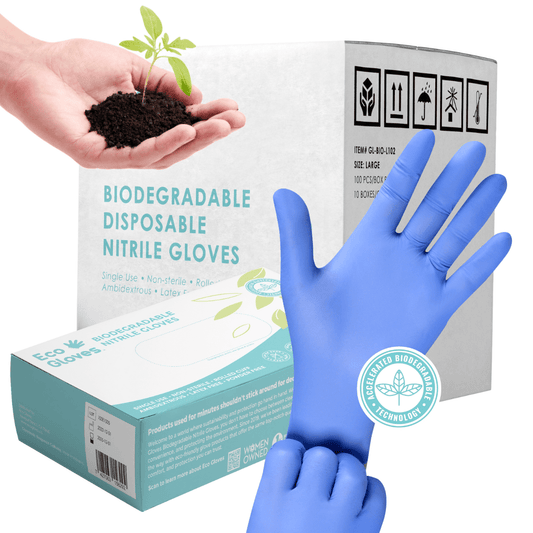The Best Disposable Gloves for Food Handling: Safe and Compliant Picks
Eco GlovesIn any kitchen setting—from bustling restaurants to home kitchens—gloves are a key component in protecting both the food and the people who eat it. Choosing the right disposable gloves for food handling is more than just a matter of convenience. It's essential for maintaining cleanliness, food safety, and regulatory compliance.
The consequences of using inappropriate or non-compliant gloves can be serious. According to the CDC, improper glove use is one of the leading contributors to foodborne illness outbreaks in food service environments. That’s why selecting food-safe gloves—those specifically designed to meet FDA requirements and prevent contamination—is critical to every food prep operation.
The market offers a wide variety of gloves for food prep, but not all gloves are created equal. Understanding the differences in materials, fit, and safety standards can help consumers and food service professionals make informed choices that reduce risk and support hygiene best practices.
Topics Covered
- What Makes a Glove Safe for Food Handling?
- Best Types of Disposable Gloves for Food Handling
- Colored Gloves for Food Safety: Why It Matters
- When to Change Gloves in Food Handling
- Eco Gloves’ Top Picks for Food Handling
- Make the Safe, Smart Choice for Your Kitchen
- Key Takeaways: Choosing the Best Disposable Gloves for Food Handling
- Frequently Asked Questions About (FAQ)
What Makes a Glove Safe for Food Handling?
Before diving into glove types, it’s important to understand the standards that define safe gloves for cooking. In the U.S., any glove used for food handling must comply with specific guidelines from the Food and Drug Administration (FDA) and the U.S. Department of Agriculture (USDA). These regulations are in place to prevent chemicals, allergens, or debris from transferring to food.
FDA and USDA Compliance
Gloves that are labeled as FDA-compliant gloves have been tested and approved for direct food contact under FDA Title 21 CFR Part 177. This means the materials used do not pose any risk of contaminating food during handling. USDA compliance is often required in facilities processing meat, poultry, or egg products, and it includes additional sanitation standards.
Powder-Free Requirement
For safety and cleanliness, powder-free gloves are recommended for all food service tasks. Powdered gloves, once common in kitchens, have been largely phased out due to their potential to carry allergens and contaminate prepared food.
Non-Toxic Materials
The composition of food-grade gloves matters. They should be made from non-toxic, chemical-safe materials that won’t degrade during use. BPA-free plastics and phthalate-free vinyl are preferred for low-risk tasks, while nitrile, biodegradable nitrile, and naturally-derived bioplastic gloves are ideal for more extensive food handling.
Importance of Single-Use Protocols
All gloves for food prep should be single-use to prevent cross-contamination. That means replacing gloves between different tasks, after contact with raw meat, or whenever they become soiled. Following proper glove-changing practices is just as important as choosing the right type.
Best Types of Disposable Gloves for Food Handling
Now that we’ve established what makes a glove food-safe, let’s look at the most common types of disposable gloves for food handling and how to choose the right one for your needs.
A. Polyethylene (PE) Gloves
PE gloves for food handling are one of the most commonly used types in grocery stores, sandwich shops, and cafeterias. These gloves are:
- Lightweight and loose-fitting
- Designed for short, simple tasks
- Extremely cost-effective for high-turnover stations
While PE gloves don’t offer much dexterity, they are ideal for low-risk situations like deli counter service or packaging dry food items. They are widely used because they provide a basic barrier and meet standard food safety requirements.
B. Hybrid (HDPE/LDPE) Gloves
Hybrid food gloves are a step up from traditional PE gloves. Made from a blend of high-density and low-density polyethylene, they offer:
- Improved fit and flexibility
- Increased durability for longer tasks
- A more sustainable footprint compared to traditional plastics
These gloves are a smart choice for quick-serve restaurants, salad prep stations, or any environment requiring fast glove changes.
C. Vinyl Gloves
Vinyl gloves for food handling are another popular choice due to their affordability and ease of use. Made from synthetic PVC (polyvinyl chloride), these gloves are:
- Latex-free—ideal for users or customers with latex allergies
- Looser-fitting, making them easy to put on and remove
- Suitable for short, low-risk food tasks
While vinyl gloves are not as durable or elastic as nitrile, they work well in settings where food contact is minimal or non-greasy, like assembling dry bakery goods or portioning snacks. As latex-free food gloves, vinyl is often the go-to for food businesses looking to avoid allergen concerns without breaking the budget.
However, vinyl gloves can sometimes tear under stress and offer less protection against bacteria or viruses compared to nitrile. For that reason, they’re best reserved for clean, low-risk tasks where durability isn’t critical.
D. Nitrile Gloves
When it comes to reliability, nitrile gloves for food prep are hard to beat. These gloves are made from synthetic rubber and are widely used in professional kitchens, meatpacking plants, and anywhere food handling involves high moisture, oils, or fats.
Key benefits of nitrile gloves include:
- Excellent puncture and chemical resistance
- Snug, form-fitting feel for superior dexterity
- Powder-free and latex-free construction
- Suitable for handling raw meats, seafood, or greasy ingredients
For food businesses prioritizing hygiene and performance, nitrile gloves are the premium choice. They’re especially helpful when tasks involve switching between raw and cooked foods, handling allergenic ingredients, or working with sharp tools.
Sustainability-minded kitchens may consider biodegradable nitrile gloves as an alternative. These offer the same performance as traditional nitrile while helping to reduce environmental waste.
E. Compostable Gloves (Bioplastic Alternatives)
Sustainability is becoming a top priority in the food industry, and compostable food gloves are a powerful step in that direction. These gloves are made from plant-based bioplastics, designed to break down in industrial composting conditions without leaving behind toxic residue.
Common materials include:
- PLA (Polylactic Acid) derived from cornstarch
- PBAT (Polybutylene Adipate Terephthalate), a biodegradable polymer
- Other USDA-certified bio-based materials
Benefits of bioplastic gloves for food:
- Safe for handling light, non-greasy foods
- Compliant with FDA food contact regulations
- Ideal for cafes, juice bars, food trucks, and environmentally focused restaurants
Many eco-friendly food gloves fall into this category, offering a more responsible alternative without sacrificing safety.
Colored Gloves for Food Safety: Why It Matters
Colored food gloves aren’t just about branding or aesthetics—they’re a smart food safety tool. In environments where cross-contamination is a risk, using different glove colors for specific food types can minimize errors and improve hygiene.
Here’s how food prep glove color coding is typically implemented:
- Blue gloves for food handling: Used for raw meat since blue is easily visible and not a color found in natural foods
- Green gloves: Reserved for fruits, vegetables, and plant-based items
- White or clear gloves: Best for light-duty tasks like prep work and/or ready-to-eat food handling
- Pink gloves: Designated for cooked or ready-to-eat foods or cleaning tasks
- Black gloves: Generally used in cooking, frying, handling of greasy foods
This system not only helps workers keep tasks separated, but it also makes it easier to detect glove fragments if one tears during use. When gloves break or are misused, visual cues can make the difference between catching a problem early and letting a contaminant reach a customer’s plate.
When to Change Gloves in Food Handling
How often to change food gloves is just as important as selecting the right glove material. Wearing gloves for too long or between tasks can increase the risk of transferring bacteria, allergens, or cleaning residues.
According to the FDA Food Code, you should change gloves:
- After handling raw meat, poultry, or seafood
- When switching between food types, especially if allergens are involved
- After taking out trash, touching hair, face, or cellphone
- When gloves become visibly dirty, greasy, torn, or sweaty
Practicing proper glove hygiene in food service protects your customers and your compliance record. Remember, gloves are not a substitute for handwashing—they’re a protective layer that should be used in tandem with good hygiene habits.
Eco Gloves’ Top Picks for Food Handling
Eco Gloves is proud to offer a full range of FDA food-safe gloves designed for kitchens that care about cleanliness, comfort, and sustainability. Whether you're a food service professional or a home cook, you'll find gloves that meet your standards and reflect your values.
Explore Our Food-Grade Options:
- Biodegradable Nitrile Gloves: Durable, chemical-resistant, and perfect for greasy or allergen-heavy prep without the environmental guilt.
- Compostable Gloves for Food Handling: A top choice for juice bars, eco-conscious restaurants, or markets seeking single-use plant-based gloves that reduce landfill waste.
- Hybrid and PE Gloves: Great for budget-conscious food stations handling dry, low-risk items.
- Color-Coded Options: Streamline your glove use and reduce cross-contamination with visual management.
Each product in our collection is designed with both food handling safety and sustainability in mind. And because we believe in full transparency, you’ll always find clear information on our materials, certifications, and sustainability practices.
Make the Safe, Smart Choice for Your Kitchen
Selecting the best food-handling gloves isn’t just a matter of price—it’s a commitment to health, hygiene, and sustainability. From nitrile gloves for food prep to eco-friendly disposable gloves made from plant-based materials, there’s a perfect fit for every food task and value system.
Whether you're a chef, small business owner, or environmentally conscious home cook, Eco Gloves makes it easy to protect your food and the planet at the same time. We invite you to explore our full selection of safe disposable gloves for kitchens and make the switch to better, smarter hand protection.
Shop our food handling collection today, or contact us to request a sample for your business.
Key Takeaways: Choosing the Best Disposable Gloves for Food Handling
-
Not all disposable gloves are food-safe — always look for FDA-compliant gloves made from non-toxic, powder-free materials to meet food safety regulations.
-
Nitrile gloves offer the best protection for greasy or allergen-heavy foods due to their superior durability and chemical resistance.
-
Compostable and biodegradable gloves are great eco-friendly alternatives that meet food handling requirements while reducing environmental waste.
-
Poly, hybrid, and vinyl gloves are cost-effective for low-risk food tasks, but they differ in fit, dexterity, and protection.
-
Color-coded gloves improve food safety by helping to prevent cross-contamination in busy kitchens.
-
Proper single-use and glove-changing protocols are just as critical as glove selection to maintain hygiene and compliance.
👉 Explore our full selection of food-safe disposable gloves to find the perfect fit for your kitchen’s needs.
Frequently Asked Questions (FAQ)
-
Are nitrile gloves safe for food handling?
Yes, nitrile gloves are one of the safest options for food handling. They’re FDA-compliant, latex-free, and highly resistant to oils and chemicals.
-
What color gloves are best for food prep?
Blue is typically used for raw meat, green for produce, and white or pink for ready-to-eat foods. Color coding helps prevent cross-contamination.
-
Can I use latex gloves in food service?
While technically allowed, latex gloves are generally discouraged due to the risk of allergic reactions in both food handlers and consumers. Latex-free gloves, like vinyl or nitrile, are preferred.
-
What gloves are best for cooking greasy foods?
Nitrile gloves offer the best resistance to grease, oils, and chemicals, making them ideal for meat, deep-frying, or marinade-heavy prep.
-
What are compostable food gloves made of?
Compostable food gloves are made from bioplastics like PLA or PBAT, derived from renewable resources such as corn. They’re designed to break down in commercial composting facilities.
Further Reading
- Disposable Gloves For Industrial Use: Protecting Workers From Hazards
- How to Choose the Best Disposable Gloves for Cleaning
- The History And Evolution Of Disposable Gloves: From Latex To Nitrile



















